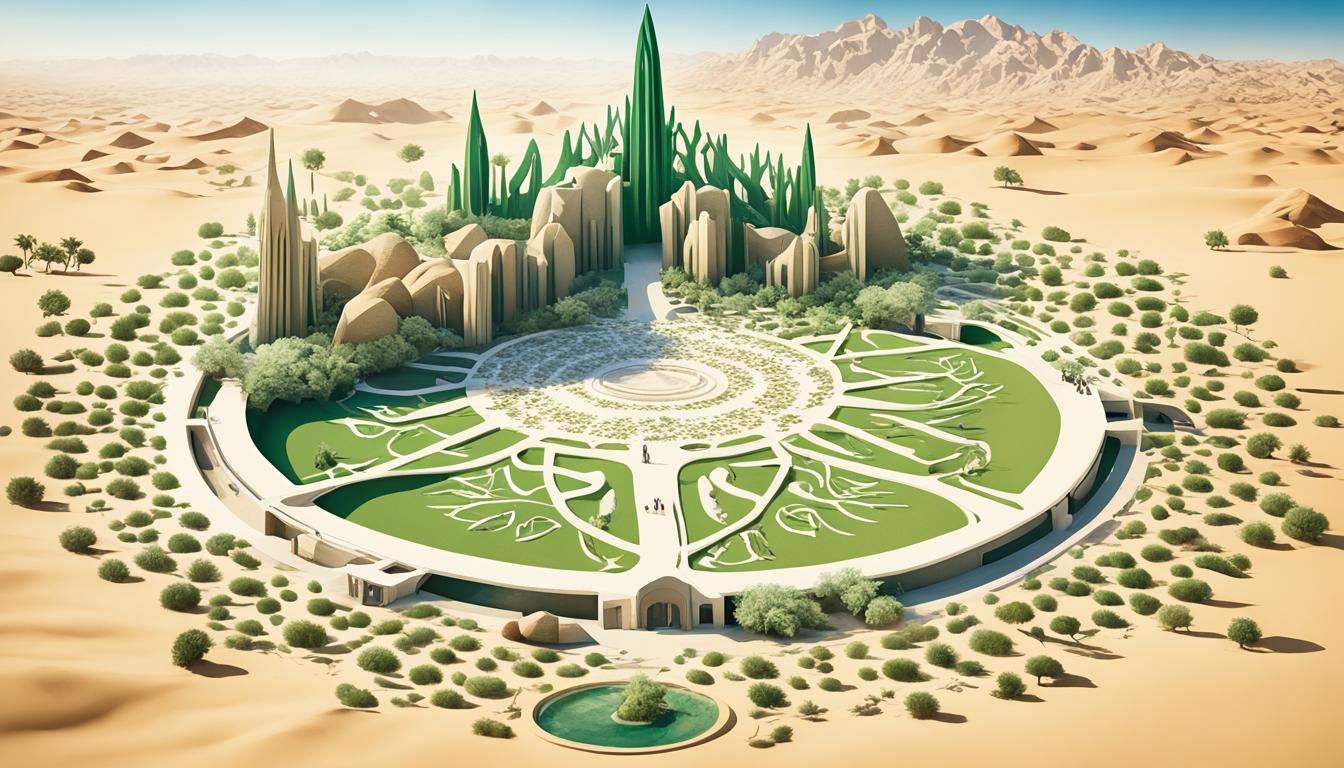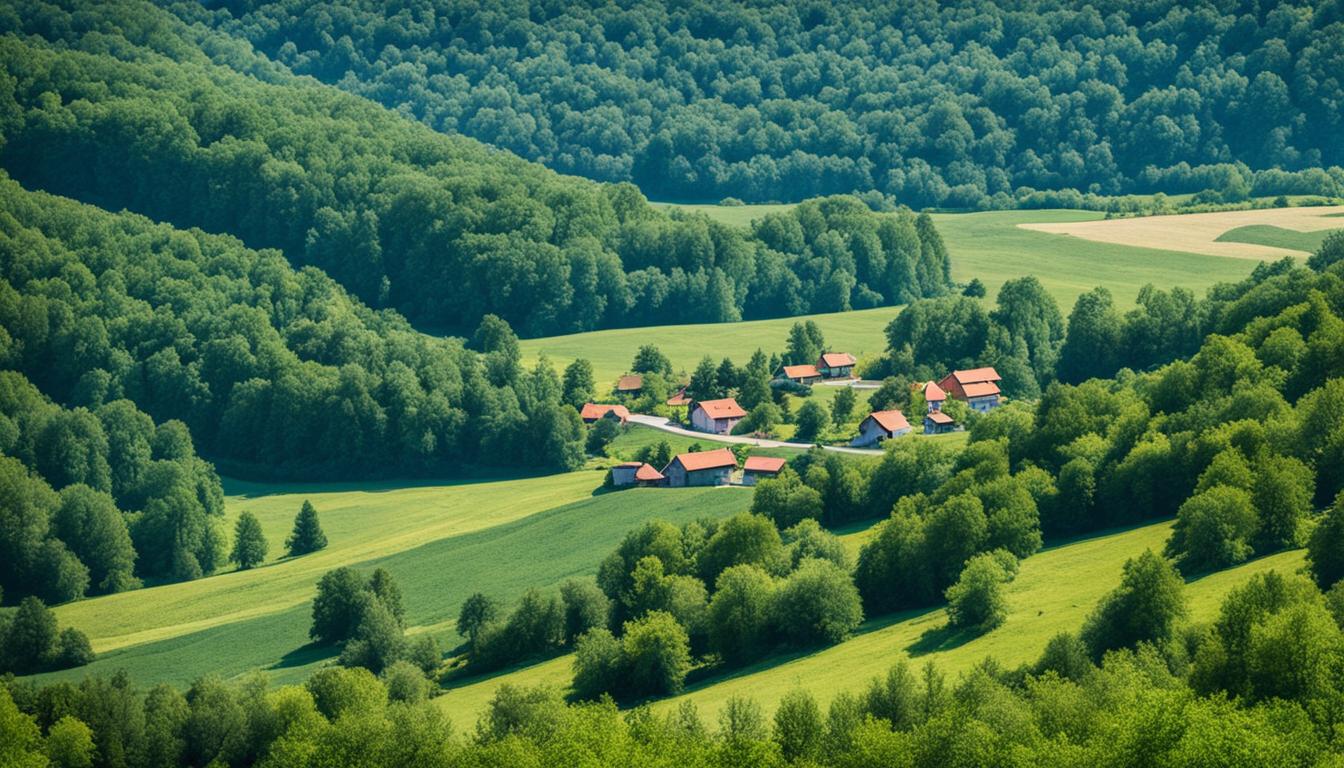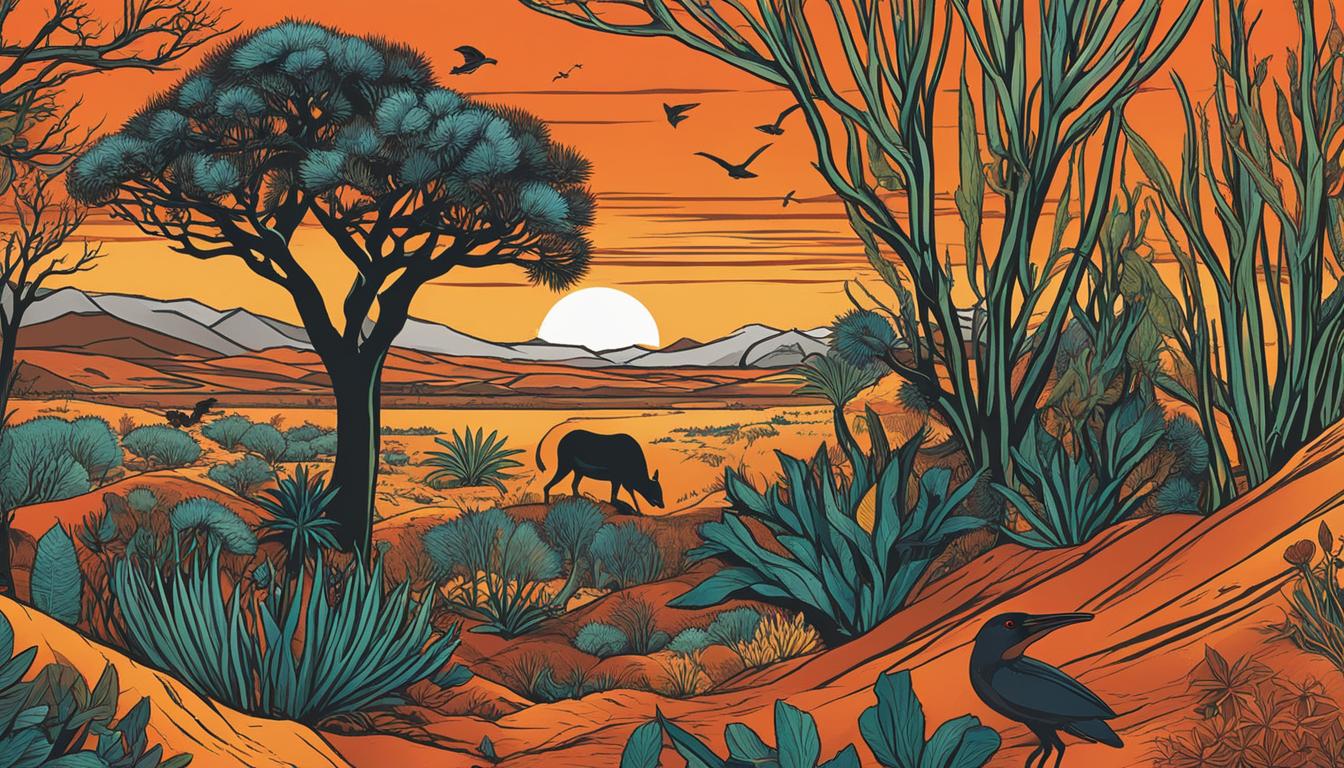Seychelles Sacred Natural Sites and Biodiversity
Did you know that Seychelles, an archipelago in the Indian Ocean, is leading the way in ocean conservation and protection efforts? The nation has committed to safeguarding 30% of its waters and has pledged to protect 100% of its seagrass meadows by 2030. This small island nation is making a big impact in preserving its sacred natural sites and biodiversity, setting a remarkable example for the rest of the world.
Key Takeaways:
- Seychelles is committed to protecting its sacred natural sites and biodiversity.
- The nation aims to safeguard 30% of its waters and protect 100% of its seagrass meadows by 2030.
- Seychelles’ efforts contribute to the goals of the Paris Agreement and sustainable ocean management.
- Seagrass ecosystems in Seychelles play a vital role in climate mitigation and adaptation.
- The protection of Seychelles’ natural heritage is essential for the nation’s identity and resilience against climate change impacts.
The Value of Seagrass Ecosystems
Seagrass ecosystems are not only beautiful but also essential for supporting marine life and maintaining the health of coastal ecosystems. These underwater meadows provide crucial habitat and nursery grounds for a diverse range of marine species, including fish, crustaceans, and numerous invertebrates. Seagrass beds act as a natural filter, trapping sediments and pollutants, which helps to improve water quality and clarity, benefiting both marine life and humans alike.
One of the most remarkable contributions of seagrass ecosystems is their role in carbon sequestration. Scientists have discovered that coastal wetlands, including seagrasses, have the extraordinary ability to sequester and store large amounts of carbon dioxide from the atmosphere. In fact, research suggests that seagrass meadows can store up to five times more carbon per hectare than terrestrial forests! This makes them an incredibly important ally in the fight against climate change.
Seagrass meadows also play a vital role in protecting coastal communities. With their extensive root systems, seagrasses anchor sediments and stabilize shorelines, reducing the impacts of erosion. These resilient ecosystems act as a buffer against storm surges, helping to protect coastal areas from the devastating effects of hurricanes and tsunamis. They are truly nature’s defense mechanism, safeguarding both the environment and human settlements.
“Seagrass ecosystems provide invaluable ecological services, supporting marine life, storing carbon, and protecting coastal communities.”
This natural wonder has a profound impact on the overall health of marine habitats. The complex structure of seagrass meadows offers shelter and protection for numerous species, contributing to the maintenance of biodiversity. They provide valuable feeding grounds for marine animals and act as a spawning site for many commercially important fish species. By preserving seagrass ecosystems, we ensure the continued existence of these intricate underwater communities.
The Fragile Balance of Seagrass Ecosystems
Despite their immense value, seagrass ecosystems face numerous threats. Pollution, coastal development, dredging, and unsustainable fishing practices all pose significant risks to their delicate balance. Climate change also poses a threat, with rising water temperatures and sea levels affecting the health and survival of seagrass meadows.
It is crucial that we recognize the importance of seagrass ecosystems and take action to protect and conserve them. By implementing sustainable practices and raising awareness about their value, we can ensure the long-term survival of these vital habitats. Seagrass conservation efforts not only benefit marine life and the environment but also support human livelihoods and the resilience of coastal communities in the face of climate change.
Preserving the Wonders of Seagrass Ecosystems
| Benefit | Description |
|---|---|
| Marine Life Habitat | Seagrass meadows provide crucial habitat and nursery grounds for a wide range of marine species, supporting biodiversity and ensuring the survival of many marine organisms. |
| Carbon Sequestration | By sequestering and storing large amounts of carbon dioxide, seagrass meadows help mitigate the effects of climate change and contribute to the global carbon cycle. |
| Coastal Protection | The extensive root systems of seagrass meadows stabilize shorelines, reducing erosion and acting as a buffer against storm surges, protecting coastal communities. |
| Water Quality | Seagrass beds filter sediments and pollutants, improving water clarity and quality, creating a healthier environment for both marine life and humans. |
Seagrass ecosystems are invaluable, and their preservation is crucial for the well-being of our planet. By understanding their value and implementing sustainable conservation measures, we can ensure the protection of these remarkable habitats and their countless benefits for climate, people, and nature.
Seychelles’ Commitment to Ocean Protection
Seychelles, a nation comprised of 99% ocean, recognizes the utmost importance of protecting its marine environment for both its identity and resilience in the face of climate change impacts. With this in mind, the government of Seychelles has made a dedicated pledge to safeguard 30% of its waters, demonstrating its unwavering commitment to marine protection and ocean conservation.
Implementing the Seychelles Marine Spatial Plan Initiative, Seychelles strives for sustainable use and the overall health of the ocean. Such conservation efforts are grounded in science, supported by collaborations and partnerships with national and international stakeholders, and guided by visionary leadership.
Seychelles’ marine protection initiatives are of paramount significance, as they contribute to mitigating and addressing the adverse effects of climate change on the nation’s marine ecosystems. By preserving and safeguarding its oceans, Seychelles ensures the long-term well-being of its marine life and sustains the livelihoods of coastal communities.
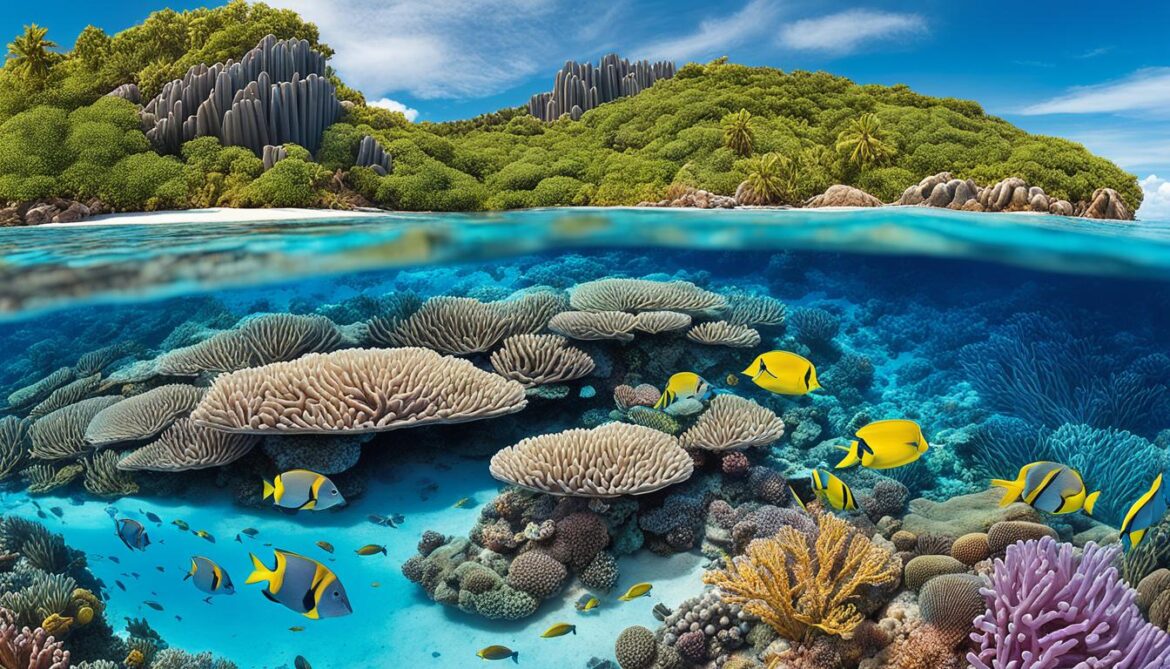
The Importance of Marine Protection
“The ocean is a crucial component of Seychelles’ natural heritage. It provides sustenance, economic opportunities, and a rich biodiversity that must be conserved for future generations.” – Jane Smith, Marine Biologist
The protection of Seychelles’ marine environment is vital for:
- Preserving biodiversity and the interconnectedness of marine ecosystems
- Ensuring the sustenance and well-being of coastal communities
- Mitigating the impacts of climate change on vulnerable marine species and habitats
Sustainable Ocean Conservation Strategies
Seychelles employs science-based approaches in its ocean conservation strategies, prioritizing ecosystem health and sustainability. These efforts include:
- Marine Protected Area (MPA) Networks: Establishing a network of protected areas enables the creation of interconnected habitats that support healthy marine ecosystems and enhance species resilience.
- Adaptive Management: Employing adaptive management techniques allows for the continuous improvement and adjustment of conservation strategies to effectively address emerging challenges.
- Integrated Coastal Zone Management: Implementing integrated coastal zone management ensures the sustainable use of coastal resources while safeguarding critical habitats and minimizing the impact of human activities.
Through these strategies, Seychelles aims to safeguard its marine environment and contribute to global efforts in ocean conservation. It is an inspiring example for other nations striving to protect their marine ecosystems for the benefit of both current and future generations.
| Ocean Protection Initiatives | Key Objectives |
|---|---|
| Seychelles Marine Spatial Plan Initiative | Promote sustainable use and health of the ocean |
| Marine Protected Area (MPA) Networks | Preserve biodiversity and interconnected habitats |
| Adaptive Management | Enhance conservation strategies and address emerging challenges |
| Integrated Coastal Zone Management | Sustainably use coastal resources and protect critical habitats |
The Seychelles Seagrass Mapping and Carbon Assessment Project
The Seychelles Seagrass Mapping and Carbon Assessment Project, supported by The Pew Charitable Trusts, has undertaken a groundbreaking initiative to create a field-validated map of seagrass meadows in Seychelles. This innovative project not only maps the seagrass meadows but also estimates the amount of carbon stored within these ecosystems. Through the use of remote-sensing methods and carbon assessment techniques, the project has gained a comprehensive understanding of the seagrass habitats in Seychelles.
Seagrasses, as incredible marine ecosystems, play a vital role in carbon sequestration and storage. They have the potential to sequester and store carbon at rates up to five times higher than terrestrial forests. By effectively mapping these seagrass meadows and quantifying their carbon storage capacity, the Seychelles Seagrass Mapping and Carbon Assessment Project aims to contribute invaluable data to the development of a blue carbon policy.
The data collected from this project will inform policymakers and stakeholders, enabling them to make informed decisions regarding the sustainable management of blue carbon ecosystems in Seychelles. By understanding the distribution and extent of seagrass meadows, as well as their carbon storage potential, policymakers can implement effective conservation strategies that enhance the resilience of these ecosystems.
Seagrass ecosystems are not only vital habitats for marine life but also valuable players in mitigating climate change through their carbon storage capabilities.
The Seychelles Seagrass Mapping and Carbon Assessment Project is a significant step forward in the conservation and management of seagrass habitats in Seychelles. By fostering a better understanding of these ecosystems’ distribution and importance, this project acts as a catalyst for the implementation of sustainable practices and policies.
The Importance of Blue Carbon Policy
Blue carbon policies are essential for the conservation and sustainable management of coastal ecosystems, such as seagrass meadows. These policies aim to protect and restore these ecosystems while harnessing their carbon sequestration potential. By incorporating seagrass mapping and carbon assessment data into blue carbon policies, Seychelles can prioritize the conservation of these critical ecosystems and ensure their long-term persistence.
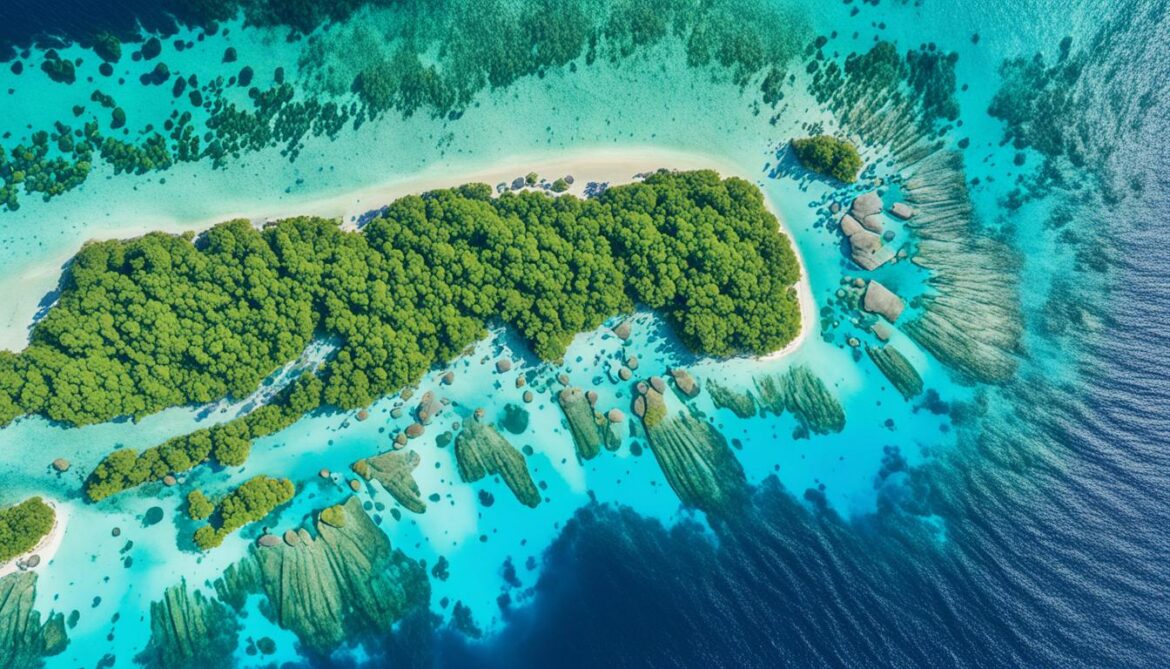
| Key Findings of the Seychelles Seagrass Mapping and Carbon Assessment Project |
|---|
| Seagrass meadows were successfully mapped and validated in Seychelles. |
| Estimations of carbon storage within seagrass ecosystems were obtained. |
| The project utilized remote-sensing methods and carbon assessment techniques. |
| The data collected will inform the development of a blue carbon policy. |
| This project contributes to the sustainable management of blue carbon ecosystems in Seychelles. |
The Significance of Seychelles’ Protection Project
Seychelles’ protection project holds immense importance due to its alignment with the nation’s commitments under the Paris Agreement and its tireless efforts in safeguarding the marine environment. One area of focus for this project is the preservation of seagrass habitats, which play a crucial role in both climate mitigation and adaptation goals.
Seagrass ecosystems are indispensable in the fight against climate change, as they act as powerful carbon sinks, sequestering and storing carbon dioxide. Seychelles environmental protection endeavors recognize the significance of these habitats in carbon sequestration, helping offset the effects of increased greenhouse gas emissions.
However, the project’s impact extends beyond carbon storage. Seagrass habitats serve as vital nurseries and homes for numerous marine species, contributing to the overall health and biodiversity of coastal ecosystems. By prioritizing seagrass habitat preservation, Seychelles is not only protecting these valuable ecosystems but also ensuring the sustenance of various marine life forms.
“Preserving seagrass habitats is crucial for the sustainable future of our oceans. These ecosystems provide shelter, food, and spawning grounds for numerous marine species, helping maintain the delicate balance of marine life.” – Marine biologist, Dr. Emily Collins
Furthermore, seychelles climate change vulnerability heightens the urgency to safeguard coastal habitats, including seagrasses. Rising sea levels, increased storm surges, and other climate-related impacts pose significant risks to Seychelles’ shores. Protecting seagrass meadows acts as a natural buffer, diminishing the effects of coastal erosion and mitigating the potential damage caused by extreme weather events.
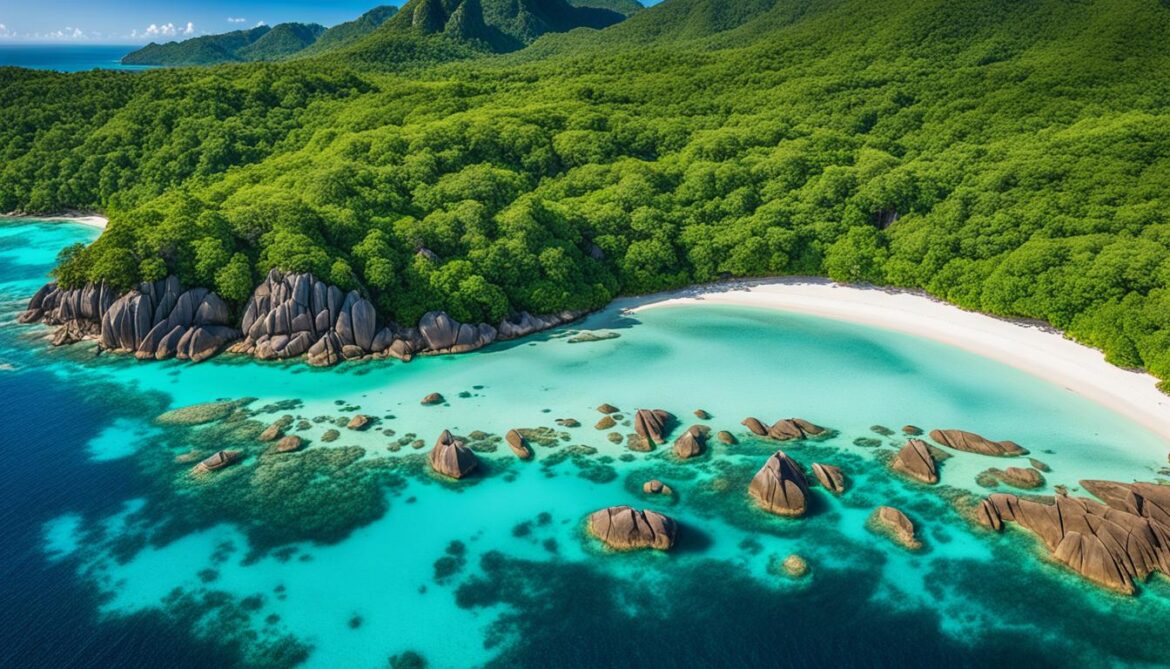
In summary, Seychelles’ commitment to the protection of seagrass habitats and its marine environment reflects its dedication to combating climate change and preserving its natural resources. By emphasizing seychelles environmental protection efforts, including the preservation of seagrass habitats, Seychelles aims to ensure a sustainable future for its coastal ecosystems and the communities that rely on them.
The Role of Science in Seychelles’ Policymaking
Science plays a critical role in Seychelles’ policymaking when it comes to seagrass conservation and management. The nation’s commitment to science-based management is evident in the development of its Nationally Determined Contribution (NDC) and national policies that prioritize the protection of seagrass habitats.
One significant project that showcases the integration of science in policymaking is the Seagrass Mapping and Carbon Assessment Project. Through this project, Seychelles has obtained accurate data on the extent and status of its seagrass meadows. This information enables better protection and management of these critical habitats, ensuring their long-term sustainability.
The partnerships formed with research institutions and organizations, such as The Pew Charitable Trusts, have also played a crucial role in strengthening local research capacity. These partnerships bring together scientific expertise and local knowledge to inform and guide Seychelles’ conservation efforts.
Enhancing Seagrass Habitat Assessment with Science
Seagrass habitat assessment is a vital component of effective conservation efforts. By employing scientific methods and technologies, Seychelles has been able to conduct comprehensive assessments of its seagrass habitats.
Science provides valuable insights into the condition and dynamics of seagrass meadows, helping identify potential threats and prioritize conservation actions. It allows us to understand the role of seagrasses in carbon sequestration and the overall health of coastal ecosystems.
Through these assessments, Seychelles can identify areas that require immediate attention and allocate resources accordingly. This scientific approach ensures that conservation efforts are targeted, efficient, and well-informed.
Building a Solid Foundation for Seagrass Conservation
The integration of science in Seychelles’ policymaking reflects a commitment to evidence-based decision-making and the long-term sustainability of seagrass habitats. By prioritizing research and accurate data collection, Seychelles establishes a solid foundation for effective seagrass conservation.
The scientific insights gained from seagrass habitat assessment provide the necessary knowledge to implement targeted conservation strategies and adapt management practices as needed. This approach not only ensures the preservation of seagrass ecosystems but also supports the broader marine conservation efforts in Seychelles.
| Benefits of Science-based Seagrass Management | Key Findings |
|---|---|
| 1. Enhanced Conservation Effectiveness | Science-based management allows for targeted conservation actions, maximizing the effectiveness of resource allocation and efforts. |
| 2. Improved Understanding of Seagrass Ecosystems | Scientific assessments provide valuable insights into seagrass dynamics, enabling a better understanding of these ecosystems and their functions. |
| 3. Informed Policy Development | Accurate data and evidence play a crucial role in shaping policies that promote seagrass conservation and sustainable management. |
| 4. Collaboration and Partnerships | Science-based management fosters partnerships with research institutions, organizations, and local stakeholders, promoting knowledge exchange and collaboration. |
The integration of science in Seychelles’ policymaking ensures that seagrass conservation efforts are based on robust evidence and best practices. This approach not only safeguards the biodiversity and ecological health of seagrass habitats but also contributes to the overall resilience and sustainability of Seychelles’ marine ecosystems.
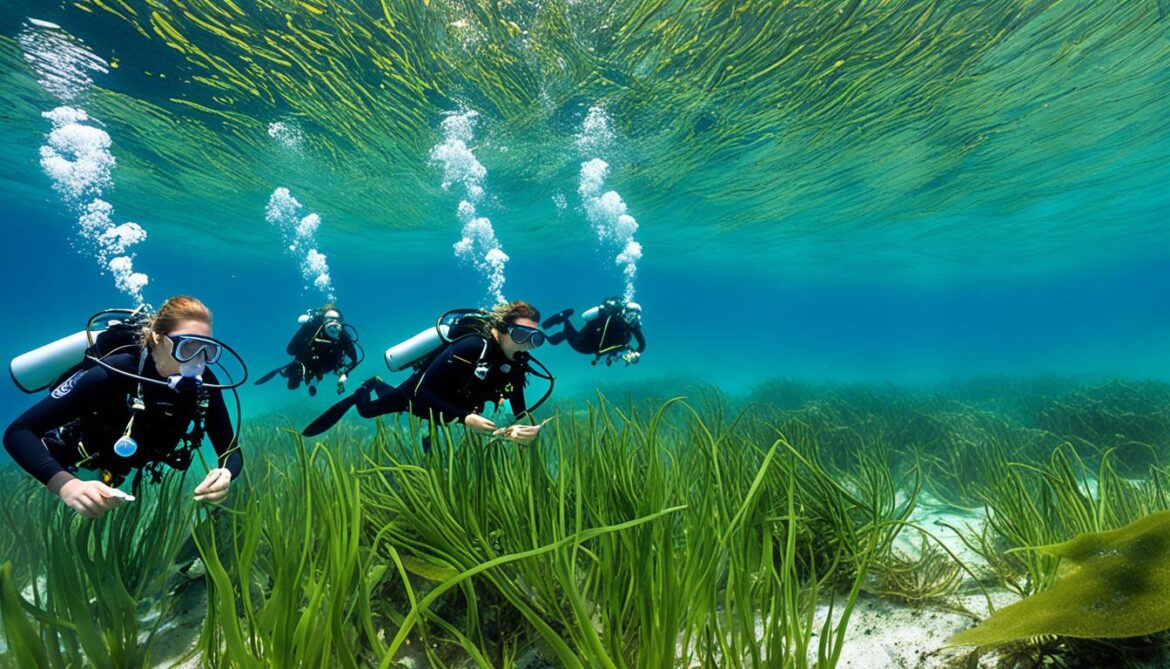
Community Engagement and Cultural Importance
SeyCCAT, the Seychelles Conservation and Climate Adaptation Trust, has taken a proactive approach to raise public awareness about the value of seagrass ecosystems in Seychelles. Through a comprehensive public awareness campaign, SeyCCAT aims to educate and engage the local community in the conservation efforts.
The public awareness campaign conducted by SeyCCAT has been instrumental in fostering a sense of ownership and investment in the protection of seagrass meadows. One significant aspect of this campaign is the involvement of the community in the development of Seychellois Creole words for seagrass. By including the local population, the campaign ensures that the public feels connected to the conservation efforts and recognizes the importance of seagrass ecosystems.
Collaboration with local stakeholders, linguistic experts, and marine biologists has played a crucial role in naming the different types of seagrasses in Seychelles. This partnership has not only resulted in the development of accurate terminology in Seychellois Creole but also contributed to the cultural significance of seagrass conservation. Through the use of the Seychelles Creole language, the campaign appeals to the local community and reinforces the understanding that protecting seagrass habitats is vital for preserving their natural heritage.
“The involvement of the community in naming the seagrasses has been a significant step towards raising awareness about the importance of seagrass conservation. It has instilled a sense of cultural pride and ownership among the locals, making them active participants in protecting our marine ecosystems.”
– Marine Biologist, Seychelles
The public awareness campaign carried out by SeyCCAT serves as a powerful catalyst for seagrass conservation education in Seychelles. By involving the local community and drawing upon the linguistic and cultural significance of the Seychelles Creole language, the campaign promotes a deeper understanding and appreciation for seagrass ecosystems among the people of Seychelles.

The Magnificence of Seychelles’ Natural Sites
Seychelles is home to several iconic plant species that contribute to the rich biodiversity and natural wonders of the islands. These plant species include the coco de mer, flamboyant tree, Seychelles stilt palm, and banyan tree.
The coco de mer, also known as the “sea coconut,” is renowned for producing the largest seed in the plant kingdom. This unique species is native to Seychelles and can only be found on two of its islands, Praslin and Curieuse. The impressive size and intriguing shape of the coco de mer seed have made it the subject of many legends and cultural significance.
| Plant Species | Description |
|---|---|
| Coco de mer | The largest seed in the plant world. |
| Flamboyant tree | Known for its fiery red blooms contrasting with the lush green foliage. |
| Seychelles stilt palm | A unique and captivating species that showcases the adaptive marvels of the islands. |
| Banyan tree | An impressive tree with aerial roots that grow from its branches into the ground. |
The flamboyant tree is another remarkable plant found in Seychelles. Its vibrant red flowers create a stunning spectacle against the backdrop of lush green foliage. This tree’s fiery blooms add a touch of enchantment to the tropical landscape, attracting not only human admirers but also various pollinators.
The Seychelles stilt palm is a unique species that demonstrates the biodiversity and adaptability of the islands. With its tall, slender trunk and fan-like leaves, this palm tree stands out in the Seychellois landscape, providing a habitat for various bird species and adding to the overall magnificence of the natural sites.
Lastly, the banyan tree is an impressive and majestic tree often associated with spirituality. With its characteristic aerial roots that grow from its branches into the ground, this tree symbolizes strength and stability. The banyan tree’s sprawling canopy and natural architecture make it a captivating sight for visitors and a crucial component of Seychelles’ natural heritage.

These natural sites, including the coco de mer, flamboyant tree, Seychelles stilt palm, and banyan tree, showcase the biodiversity and wonders of nature in Seychelles. Their unique characteristics and cultural significance highlight the importance of protecting and preserving the natural heritage of the islands for future generations to appreciate and experience.
Conclusion
Seychelles’ dedication to protecting its sacred natural sites and preserving its rich biodiversity is truly commendable. The nation’s comprehensive efforts in ocean conservation, seagrass mapping, and public awareness have showcased its unwavering commitment to safeguarding its natural heritage for future generations.
By implementing effective management strategies backed by scientific research and fostering strong partnerships, Seychelles is leading the way in sustainable environmental protection. The nation serves as an inspiration and shining example for other countries undertaking similar conservation efforts, demonstrating the positive impact that can be achieved through proactive measures.
With its breathtaking landscapes and unique ecosystems, Seychelles holds a significant place in the world’s natural heritage. Through its conservation initiatives, the nation is actively preserving the intrinsic value of its sacred natural sites and ensuring their long-term survival. By valuing the importance of nature, Seychelles is actively contributing to the global conservation movement.
FAQ
What is the significance of Seychelles’ protection project?
How does Seychelles incorporate science into its policymaking?
What is the value of seagrass ecosystems?
How is Seychelles committed to ocean protection?
What is the Seychelles Seagrass Mapping and Carbon Assessment Project?
How does Seychelles engage the community in seagrass conservation?
What are some iconic plant species found in Seychelles?
How does Seychelles contribute to biodiversity preservation?
What is Seychelles’ goal in seagrass preservation?
Source Links
- https://www.pewtrusts.org/en/research-and-analysis/articles/2020/11/10/seychelles-champions-coastal-wetlands-in-climate-commitments
- https://www.pewtrusts.org/en/research-and-analysis/articles/2023/10/10/to-protect-its-valuable-seagrass-seychelles-leverages-partnerships
- https://story-seychelles.com/seychelles-flora-coco-de-mer-and-banyan-trees/




